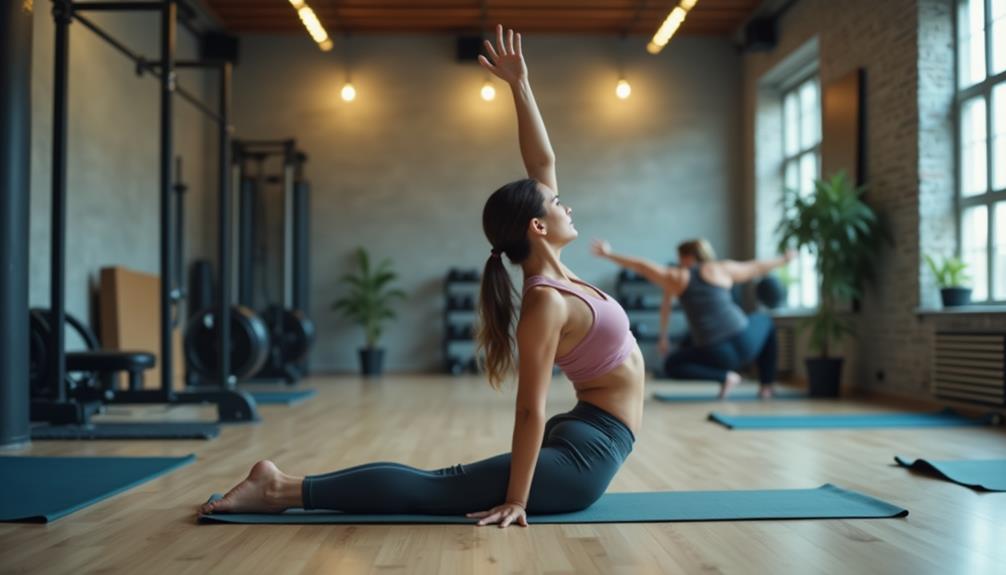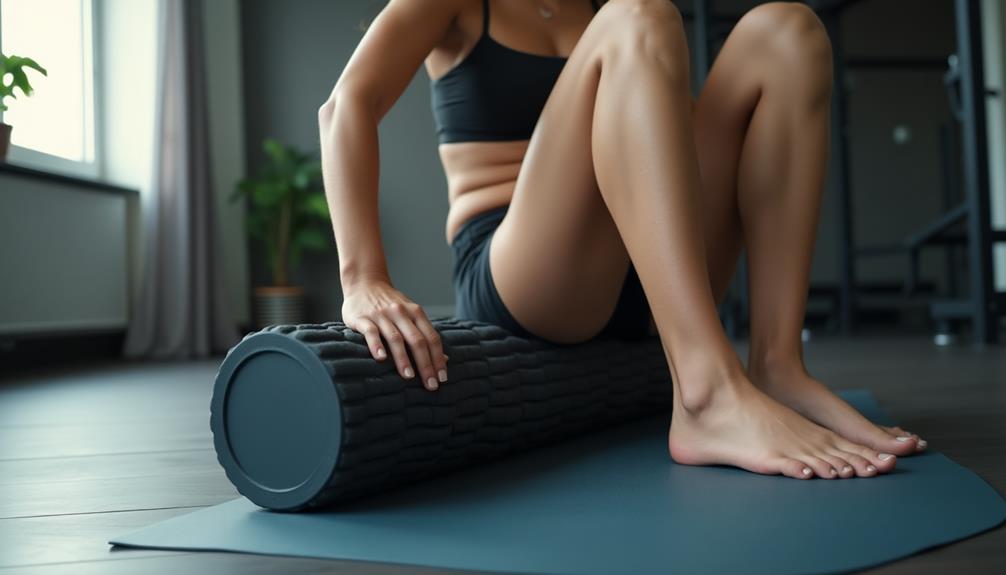Cooling down after hypertrophy workouts is essential for recovery. Start with active recovery, like light walking, to gradually lower your heart rate. Hydrate with water or an electrolyte drink to replenish fluids. Next, perform static stretches for major muscle groups, holding each for 15 to 30 seconds. Target specific muscles that were worked, using foam rolling to relieve tightness. Incorporate deep breathing to reduce heart rate and relax muscle tension. Finally, remember to nourish your body with a post-workout snack. Following these steps can greatly enhance your workout experience, and there's more to discover about effective cooling down techniques.
Core Insights
- Begin with 5-10 minutes of light activity, such as walking, to gradually lower heart rate and body temperature.
- Hydrate with water or recovery drinks, and consider electrolyte powders to replenish lost minerals.
- Perform static stretches for major muscle groups, holding each for 15 to 30 seconds to enhance flexibility.
- Incorporate foam rolling techniques to alleviate muscle tightness and improve mobility in worked areas.
- Practice deep breathing and progressive muscle relaxation to reduce tension and enhance overall recovery.
Importance of Cooling Down

Why should you prioritize cooling down after hypertrophy workouts? Cooling down is essential for your body's recovery. It helps reduce muscle soreness and stiffness, allowing you to feel better in your next session. When you finish a workout, your heart rate and body temperature are elevated. Gradually lowering these levels through cooling down can prevent dizziness or fainting.
Moreover, cooling down aids in the removal of metabolic waste products, which can accumulate during intense exercise. This process supports faster recovery, keeping your muscles primed for growth. Finally, taking time to cool down gives you a moment to reflect on your workout, enhancing your overall training experience. Prioritizing this practice will contribute to your long-term fitness success and well-being.
Gradual Heart Rate Reduction

- Active Recovery: Keep moving with light activities like walking or slow cycling for 5 to 10 minutes. This helps maintain blood flow and eases your heart rate shift. Consider incorporating top hydration powders into your post-workout routine to replenish electrolytes and support prime recovery.
- Controlled Breathing: Practice deep breathing techniques. Inhale slowly through your nose, hold for a moment, then exhale through your mouth. This calms your body.
- Hydration: Drink water or a recovery drink. Staying hydrated supports your cardiovascular system and aids in recovery.
Effective Stretching Techniques

Effective stretching techniques are essential for enhancing flexibility and promoting recovery after hypertrophy workouts. Start with static stretches, focusing on major muscle groups, holding each stretch for 15 to 30 seconds. This helps elongate muscles and improves range of motion. Consider using compression sleeves for targeted support and faster recovery in specific muscle areas. These sleeves can help stabilize muscles and reduce post-workout pain.
Next, incorporate dynamic stretches, which involve movement. Try leg swings or arm circles to keep blood flowing and prevent stiffness.
Don't forget to breathe deeply during each stretch; this can enhance relaxation and improve your overall stretch quality.
Targeting Key Muscle Groups

How can you secure your recovery routine effectively targets key muscle groups after hypertrophy workouts? Focusing on the muscles you've just trained is essential for recovery and growth. Here's how you can guarantee you're addressing these areas:
- Identify Your Target Muscles: Take a moment to pinpoint which muscle groups you've worked on during your session, like chest, back, or legs.
- Incorporate Specific Stretches: Use stretches that directly engage these muscle groups. For example, a doorway stretch for the chest or a seated forward bend for the hamstrings.
- Utilize Foam Rolling: Apply foam rolling techniques to alleviate tightness in the targeted areas, promoting blood flow and reducing soreness. High-density foam rollers are particularly effective for deep tissue massage and myofascial release, enhancing flexibility and mobility in the muscles you've worked.
Implementing these steps will enhance your recovery and prepare your muscles for future workouts.
Breathing and Relaxation Methods

After targeting key muscle groups, it's important to integrate breathing and relaxation methods into your recovery routine. Start by practicing deep breathing. Inhale slowly through your nose, filling your lungs completely. Hold for a moment, then exhale gently through your mouth. Repeat this for a few minutes to lower your heart rate and reduce tension.
Next, consider progressive muscle relaxation. Tense each muscle group for a few seconds, then release. This helps you identify and let go of any lingering tightness.
Hydration and Nutrition Post-Workout

Proper hydration and nutrition play an essential role in your recovery after hypertrophy workouts. After you've pushed your limits, refueling your body is vital to aid muscle recovery and replenish lost nutrients.
Here are three key steps to focus on:
- Rehydrate: Drink plenty of water or electrolyte-rich beverages to replace fluids lost during your workout. Aim for at least 16-20 ounces within the first hour.
- Protein Intake: Consume a protein-rich meal or shake within 30 minutes post-workout. This helps repair muscle fibers and promotes growth.
- Carbohydrates: Include complex carbohydrates in your meal to replenish glycogen stores. Foods like brown rice, sweet potatoes, or whole-grain bread are excellent options.
Foam Rolling Benefits

Using a foam roller can improve your overall recovery time, allowing you to get back to your workouts sooner. Additionally, it aids in reducing stiffness, which can occur after intense hypertrophy sessions.
Incorporating Cool Down Into Routine

Incorporating a cool down into your routine is essential if you want to maximize recovery and enhance performance. After an intense hypertrophy workout, taking the time to cool down helps your body shift back to a resting state. Here's how to effectively integrate cool down into your post-workout regimen:
- Stretching: Spend 5-10 minutes performing static stretches targeting the muscles you worked. This helps improve flexibility and reduce soreness.
- Light Cardio: Engage in 5 minutes of light cardio, like walking or cycling at a low intensity, to gradually decrease your heart rate.
- Hydrate: Don't forget to drink water or a recovery drink. Proper hydration aids in muscle recovery and overall performance.
Frequently Asked Questions
Can I Skip Cooling Down if I'm Short on Time?
You might think skipping the cool down saves time, but it's not worth it. Cooling down helps prevent injury and aids recovery, so even a short cool down can make a big difference.
How Long Should a Cooldown Typically Last?
A cooldown typically lasts around 5 to 10 minutes. You should focus on gentle stretching and light movement to help your body shift back to a resting state and reduce muscle soreness later.
What Common Mistakes Should I Avoid During Cooldown?
During cooldown, avoid rushing through stretches, skipping hydration, and neglecting deep breathing. Don't forget to listen to your body; if something feels off, adjust your routine to guarantee a proper recovery.
Is It Necessary to Cool Down After Every Workout?
Yes, it's necessary to cool down after every workout. This helps your heart rate gradually return to normal, reduces muscle stiffness, and promotes recovery, ensuring you feel better and perform well in your next session.
Should I Cool Down Differently for Different Types of Workouts?
Yes, you should cool down differently for various workouts. High-intensity sessions might need longer stretches, while lighter workouts can require quicker, simpler cooldowns. Tailor your approach to match the intensity and focus of each workout type.

